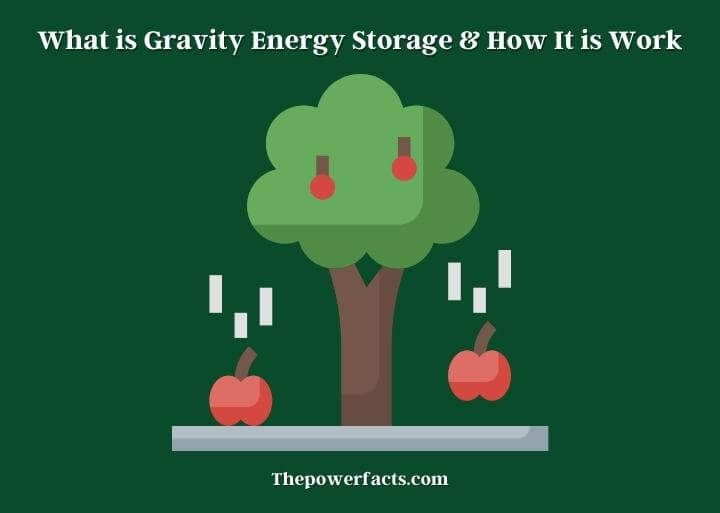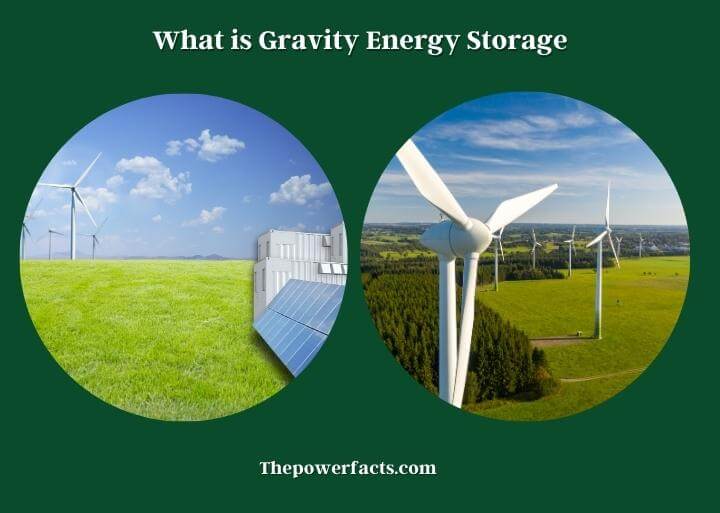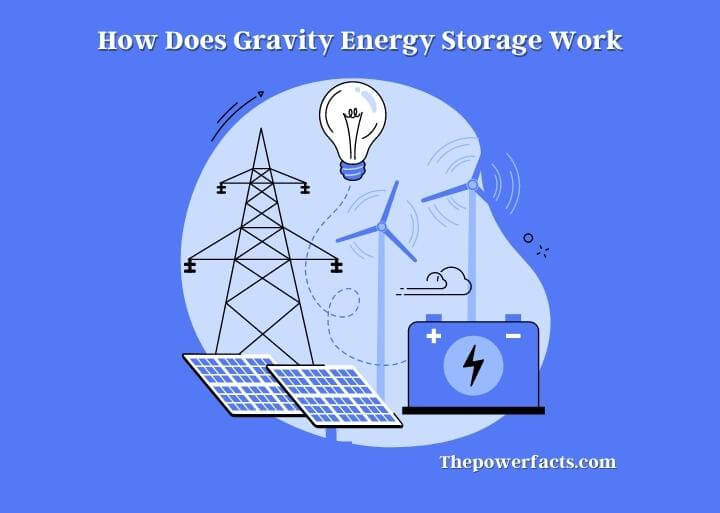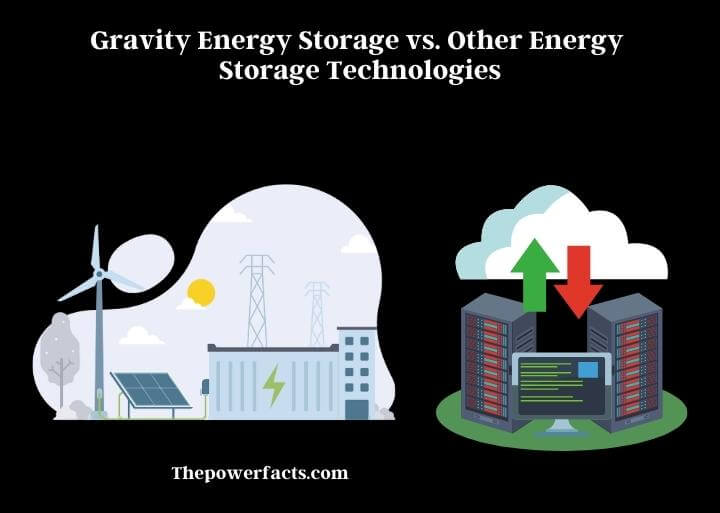Energy storage has become a crucial aspect of renewable energy systems. As renewable energy sources such as solar and wind become more popular, the demand for efficient and cost-effective energy storage solutions increases. One such solution is gravity energy storage.

Gravity energy storage systems store energy in the form of potential energy by raising heavy objects or lifting water to higher elevations. When the energy is needed, the objects or water are allowed to fall or flow down, which generates kinetic energy that can be converted into electricity.
What is Gravity Energy Storage?
Gravity energy storage is a form of mechanical energy storage that uses the earth’s gravity to store energy. The energy is stored in the form of potential energy, which is the energy that an object possesses due to its position relative to other objects. The higher an object is placed, the greater its potential energy.
Gravity energy storage systems typically consist of a heavy object or a large body of water that is lifted to a higher elevation using energy from an external source, such as renewable energy sources. When energy is needed, the object or water is allowed to fall or flow down, which drives a turbine that generates electricity.

Types of Gravity Energy Storage
There are several types of gravity energy storage systems, including:
Pumped Hydro Energy Storage
Pumped hydro energy storage is the most common form of gravity energy storage. It involves pumping water from a lower reservoir to a higher reservoir during periods of low electricity demand. When the electricity demand is high, the water is released from the higher reservoir, which flows down through a turbine, generating electricity.
Solid Block Gravity Energy Storage
Solid block gravity energy storage involves lifting a heavy solid block, such as a concrete block, to a higher elevation using a crane or a hoist. When energy is needed, the block is allowed to fall, which drives a generator to produce electricity.
Gravitricity
Gravitricity is a new form of gravity energy storage that involves lifting weights using a winch or a cable to store energy. When the energy is needed, the weights are released, which drives a generator to produce electricity.
Mountain Gravity Energy Storage
Mountain gravity energy storage involves storing energy in the form of potential energy in a mountain or a hill by pumping water to a higher elevation during periods of low electricity demand. When the electricity demand is high, the water is released, which flows down through a turbine, generating electricity
How Does Gravity Energy Storage Work?
The process of gravity energy storage varies depending on the type of system being used. Here is a breakdown of how each system works:

Pumped Hydro Energy Storage Process
- During periods of low electricity demand, water is pumped from a lower reservoir to a higher reservoir using energy from renewable energy sources, such as wind or solar.
- When the electricity demand is high, the water is released from the higher reservoir, which flows down through a turbine, generating electricity.
- The water is then returned to the lower reservoir, where it can be pumped back up to the higher reservoir for the next cycle.
Solid Block Gravity Energy Storage Process
- A heavy solid block, such as a concrete block, is lifted to a higher elevation using a crane or a hoist and held in place.
- When energy is needed, the block is allowed to fall, which drives a generator to produce electricity.
- The block is then lifted back up to its original position, where it can be held until the next cycle.
Gravitricity Process
- Weights are lifted using a winch or a cable to a higher elevation, where they are held in place.
- When the energy is needed, the weights are released, which drives a generator to produce electricity.
- The weights are then lifted back up to their original position, where they can be held until the next cycle.
Mountain Gravity Energy Storage Process
- During periods of low electricity demand, water is pumped to a higher elevation and stored in a mountain or a hill.
- When the electricity demand is high, water is released, which flows down through a turbine, generating electricity.
- The water is then returned to the lower elevation, where it can be pumped back up to the higher elevation for the next cycle.
Advantages of Gravity Energy Storage
Gravity energy storage has several advantages over other energy storage technologies, including:
- High capacity: Gravity energy storage systems have the ability to store large amounts of energy, making them ideal for grid-scale energy storage.
- Scalability: Gravity energy storage systems can be scaled up or down depending on the energy storage requirements.
- Long life: Gravity energy storage systems have a long lifespan, which can be up to several decades.
- Low maintenance: Gravity energy storage systems require minimal maintenance compared to other energy storage technologies.
- Low cost: Gravity energy storage systems are relatively low cost compared to other energy storage technologies, such as batteries.
Disadvantages of Gravity Energy Storage
Gravity energy storage also has some disadvantages, including:
- Location-dependent: Gravity energy storage systems require specific geographical features, such as mountains or hills, to function properly.
- Limited flexibility: Gravity energy storage systems are less flexible than other energy storage technologies, as they require fixed infrastructure.
- Environmental impact: Gravity energy storage systems can have an impact on the environment, such as altering water levels or disturbing wildlife habitats.
Gravity Energy Storage vs. Other Energy Storage Technologies

| Energy Storage Technology | Advantages | Disadvantages |
| Gravity Energy Storage | Scalable, long lifespan, low-cost | Location-dependent, efficiency can be affected by temperature/humidity |
| Battery Storage | High efficiency, can be used for both small and large-scale applications | Expensive, limited lifespan, can be impacted by temperature |
| Flywheel Storage | High power output, low maintenance, long lifespan | Limited energy storage capacity, can be noisy |
| Pumped Hydro Storage | Large energy storage capacity can be used for both small and large-scale applications | Location-dependent can have negative environmental impacts |
| Compressed Air Energy Storage | Scalable, low-cost | Limited energy storage capacity and efficiency can be affected by temperature/humidity |
As with any technology, each of these energy storage technologies has its own advantages and disadvantages. The choice of which technology to use depends on a variety of factors, including the specific application, the available resources, and the desired outcomes. Gravity energy storage is emerging as a promising solution that offers numerous advantages, including scalability, a long lifespan, and a low cost, making it an attractive option for a wide range of energy storage applications.
Future of Gravity Energy Storage
Gravity energy storage is an emerging technology that has the potential to revolutionize the way we store and use energy. While the technology is still in its early stages, many experts believe that gravity energy storage has a bright future ahead.
Unlike other energy storage technologies, such as batteries, gravity energy storage can be easily scaled up or down depending on the needs of a particular application. This makes it an ideal solution for large-scale energy storage applications, such as grid-scale energy storage or remote power systems.
Another advantage of gravity energy storage is its long lifespan. Gravity energy storage systems can last for decades with proper maintenance, making them a reliable and cost-effective solution for long-term energy storage.
Gravity energy storage is a relatively low-cost solution compared to other energy storage technologies. The materials and components required for gravity energy storage systems are inexpensive and readily available, making them an attractive option for energy storage applications.
As we continue to shift towards renewable energy sources, gravity energy storage will play an increasingly important role in our energy infrastructure. With its ability to store large amounts of energy, integrate renewable energy sources into the grid, and provide reliable and sustainable energy storage solutions, gravity energy storage is poised to become a key player in the future of energy storage.
There are still some challenges that need to be addressed in order to fully realize the potential of gravity energy storage. For example, the technology is highly location-dependent and may not be suitable for all applications.
Despite these challenges, the future of gravity energy storage looks bright. As research and development continue, we can expect to see even more advanced gravity energy storage systems that are even more efficient, scalable, and cost-effective. With its numerous advantages and potential for innovation, gravity energy storage is poised to play a key role in our transition toward a sustainable and renewable energy future.
Applications of Gravity Energy Storage
Gravity energy storage systems can be used for large-scale energy storage, which can help stabilize the grid and reduce the need for fossil fuel power plants.
Gravity energy storage systems can be used to power remote locations, such as off-grid communities or military bases.
Gravity energy storage systems can be used to integrate renewable energy sources, such as wind and solar, into the grid by storing excess energy generated during low-demand periods for use during high-demand periods.
Last Assumption
Gravity energy storage is an emerging technology that has the potential to revolutionize the way we store and use energy. With their high capacity, scalability, and low cost, gravity energy storage systems have the ability to provide reliable and sustainable energy storage solutions for a variety of applications.
While there are some disadvantages, such as location dependence and limited flexibility, the benefits of gravity energy storage outweigh the drawbacks. As we continue to shift towards renewable energy sources, gravity energy storage will play an increasingly important role in our energy infrastructure.